Childcare Report: Analysis of National Quality Standard 3 for Children
VerifiedAdded on 2023/01/19
|6
|761
|39
Report
AI Summary
This report examines National Quality Standard 3 (NQS) in the context of Australian childcare, as established by ACECQA. The introduction highlights the importance of NQS in setting benchmarks for early childhood education and care. The main body delves into the specifics of NQS 3, which focuses on creating a secure, favorable, and inclusive physical environment. It emphasizes the importance of providing diverse experiences to facilitate children's learning and development. The report breaks down NQS 3 into three key elements: an inclusive environment, resources that support play-based learning, and environmentally responsible practices. It discusses how each element contributes to children's skill development, knowledge, and capabilities. The conclusion reiterates the significance of adhering to NQS 3 to provide optimal learning environments for children. The report includes references to relevant academic sources.
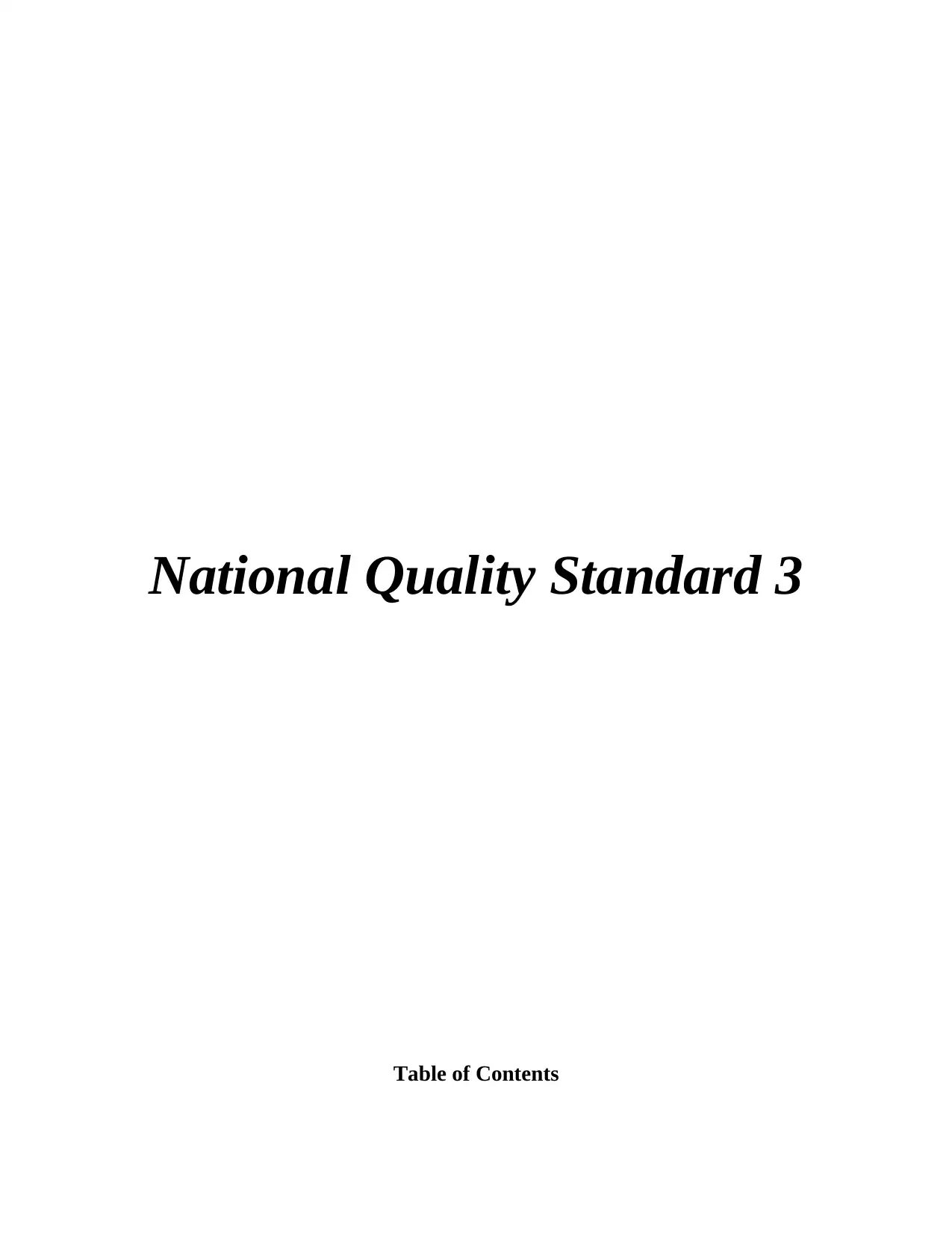
National Quality Standard 3
Table of Contents
Table of Contents
Paraphrase This Document
Need a fresh take? Get an instant paraphrase of this document with our AI Paraphraser
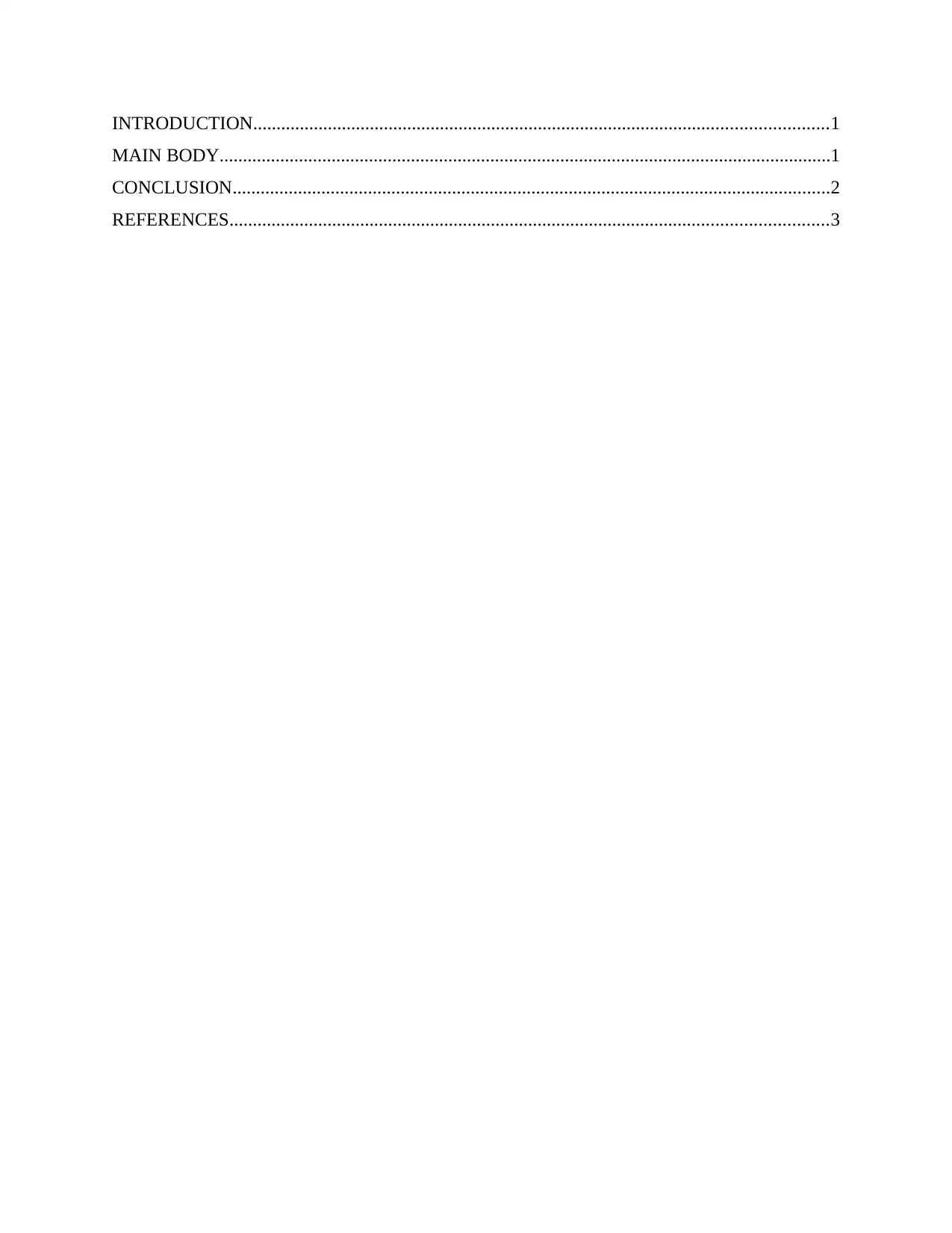
INTRODUCTION...........................................................................................................................1
MAIN BODY...................................................................................................................................1
CONCLUSION................................................................................................................................2
REFERENCES................................................................................................................................3
MAIN BODY...................................................................................................................................1
CONCLUSION................................................................................................................................2
REFERENCES................................................................................................................................3

⊘ This is a preview!⊘
Do you want full access?
Subscribe today to unlock all pages.

Trusted by 1+ million students worldwide
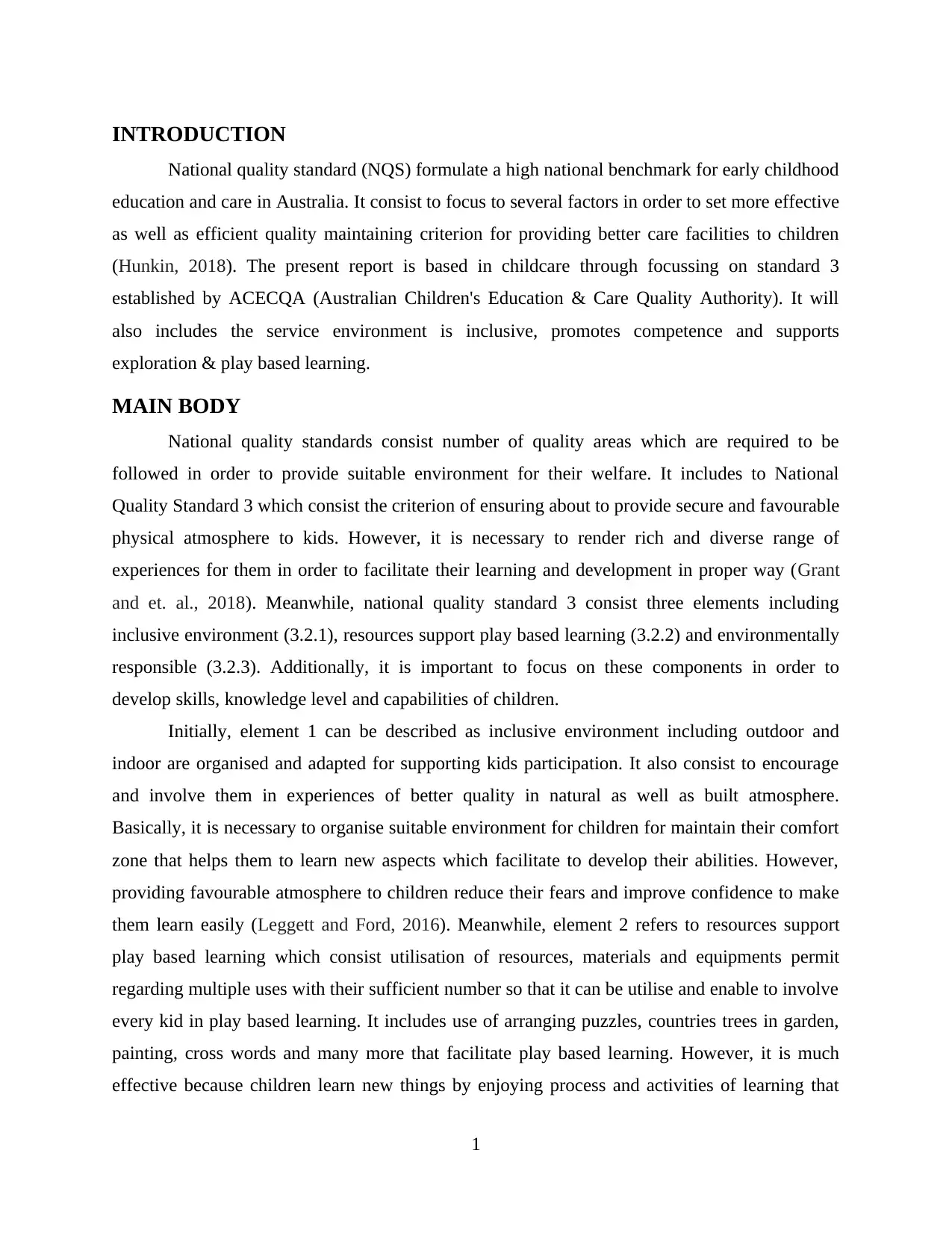
INTRODUCTION
National quality standard (NQS) formulate a high national benchmark for early childhood
education and care in Australia. It consist to focus to several factors in order to set more effective
as well as efficient quality maintaining criterion for providing better care facilities to children
(Hunkin, 2018). The present report is based in childcare through focussing on standard 3
established by ACECQA (Australian Children's Education & Care Quality Authority). It will
also includes the service environment is inclusive, promotes competence and supports
exploration & play based learning.
MAIN BODY
National quality standards consist number of quality areas which are required to be
followed in order to provide suitable environment for their welfare. It includes to National
Quality Standard 3 which consist the criterion of ensuring about to provide secure and favourable
physical atmosphere to kids. However, it is necessary to render rich and diverse range of
experiences for them in order to facilitate their learning and development in proper way (Grant
and et. al., 2018). Meanwhile, national quality standard 3 consist three elements including
inclusive environment (3.2.1), resources support play based learning (3.2.2) and environmentally
responsible (3.2.3). Additionally, it is important to focus on these components in order to
develop skills, knowledge level and capabilities of children.
Initially, element 1 can be described as inclusive environment including outdoor and
indoor are organised and adapted for supporting kids participation. It also consist to encourage
and involve them in experiences of better quality in natural as well as built atmosphere.
Basically, it is necessary to organise suitable environment for children for maintain their comfort
zone that helps them to learn new aspects which facilitate to develop their abilities. However,
providing favourable atmosphere to children reduce their fears and improve confidence to make
them learn easily (Leggett and Ford, 2016). Meanwhile, element 2 refers to resources support
play based learning which consist utilisation of resources, materials and equipments permit
regarding multiple uses with their sufficient number so that it can be utilise and enable to involve
every kid in play based learning. It includes use of arranging puzzles, countries trees in garden,
painting, cross words and many more that facilitate play based learning. However, it is much
effective because children learn new things by enjoying process and activities of learning that
1
National quality standard (NQS) formulate a high national benchmark for early childhood
education and care in Australia. It consist to focus to several factors in order to set more effective
as well as efficient quality maintaining criterion for providing better care facilities to children
(Hunkin, 2018). The present report is based in childcare through focussing on standard 3
established by ACECQA (Australian Children's Education & Care Quality Authority). It will
also includes the service environment is inclusive, promotes competence and supports
exploration & play based learning.
MAIN BODY
National quality standards consist number of quality areas which are required to be
followed in order to provide suitable environment for their welfare. It includes to National
Quality Standard 3 which consist the criterion of ensuring about to provide secure and favourable
physical atmosphere to kids. However, it is necessary to render rich and diverse range of
experiences for them in order to facilitate their learning and development in proper way (Grant
and et. al., 2018). Meanwhile, national quality standard 3 consist three elements including
inclusive environment (3.2.1), resources support play based learning (3.2.2) and environmentally
responsible (3.2.3). Additionally, it is important to focus on these components in order to
develop skills, knowledge level and capabilities of children.
Initially, element 1 can be described as inclusive environment including outdoor and
indoor are organised and adapted for supporting kids participation. It also consist to encourage
and involve them in experiences of better quality in natural as well as built atmosphere.
Basically, it is necessary to organise suitable environment for children for maintain their comfort
zone that helps them to learn new aspects which facilitate to develop their abilities. However,
providing favourable atmosphere to children reduce their fears and improve confidence to make
them learn easily (Leggett and Ford, 2016). Meanwhile, element 2 refers to resources support
play based learning which consist utilisation of resources, materials and equipments permit
regarding multiple uses with their sufficient number so that it can be utilise and enable to involve
every kid in play based learning. It includes use of arranging puzzles, countries trees in garden,
painting, cross words and many more that facilitate play based learning. However, it is much
effective because children learn new things by enjoying process and activities of learning that
1
Paraphrase This Document
Need a fresh take? Get an instant paraphrase of this document with our AI Paraphraser
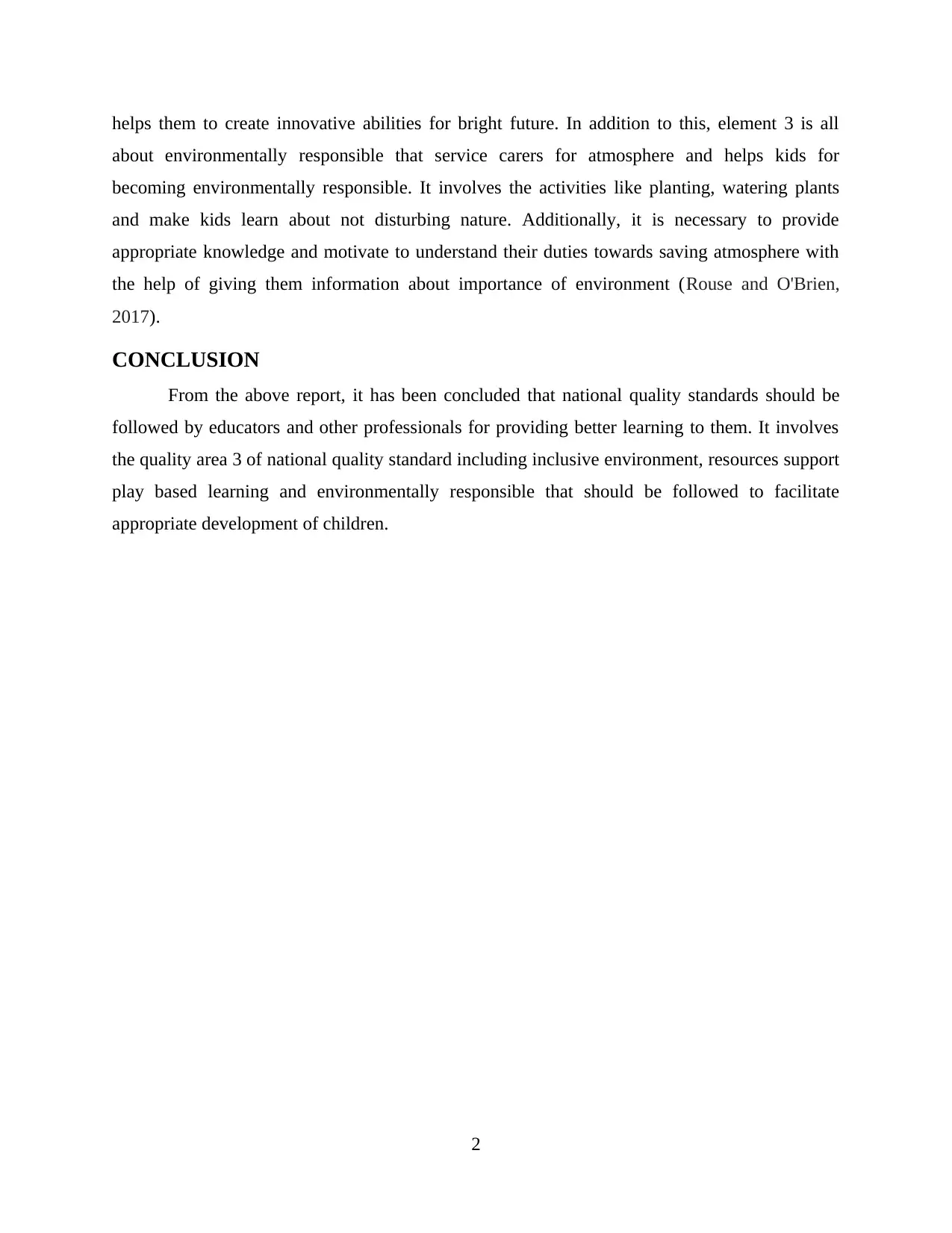
helps them to create innovative abilities for bright future. In addition to this, element 3 is all
about environmentally responsible that service carers for atmosphere and helps kids for
becoming environmentally responsible. It involves the activities like planting, watering plants
and make kids learn about not disturbing nature. Additionally, it is necessary to provide
appropriate knowledge and motivate to understand their duties towards saving atmosphere with
the help of giving them information about importance of environment (Rouse and O'Brien,
2017).
CONCLUSION
From the above report, it has been concluded that national quality standards should be
followed by educators and other professionals for providing better learning to them. It involves
the quality area 3 of national quality standard including inclusive environment, resources support
play based learning and environmentally responsible that should be followed to facilitate
appropriate development of children.
2
about environmentally responsible that service carers for atmosphere and helps kids for
becoming environmentally responsible. It involves the activities like planting, watering plants
and make kids learn about not disturbing nature. Additionally, it is necessary to provide
appropriate knowledge and motivate to understand their duties towards saving atmosphere with
the help of giving them information about importance of environment (Rouse and O'Brien,
2017).
CONCLUSION
From the above report, it has been concluded that national quality standards should be
followed by educators and other professionals for providing better learning to them. It involves
the quality area 3 of national quality standard including inclusive environment, resources support
play based learning and environmentally responsible that should be followed to facilitate
appropriate development of children.
2
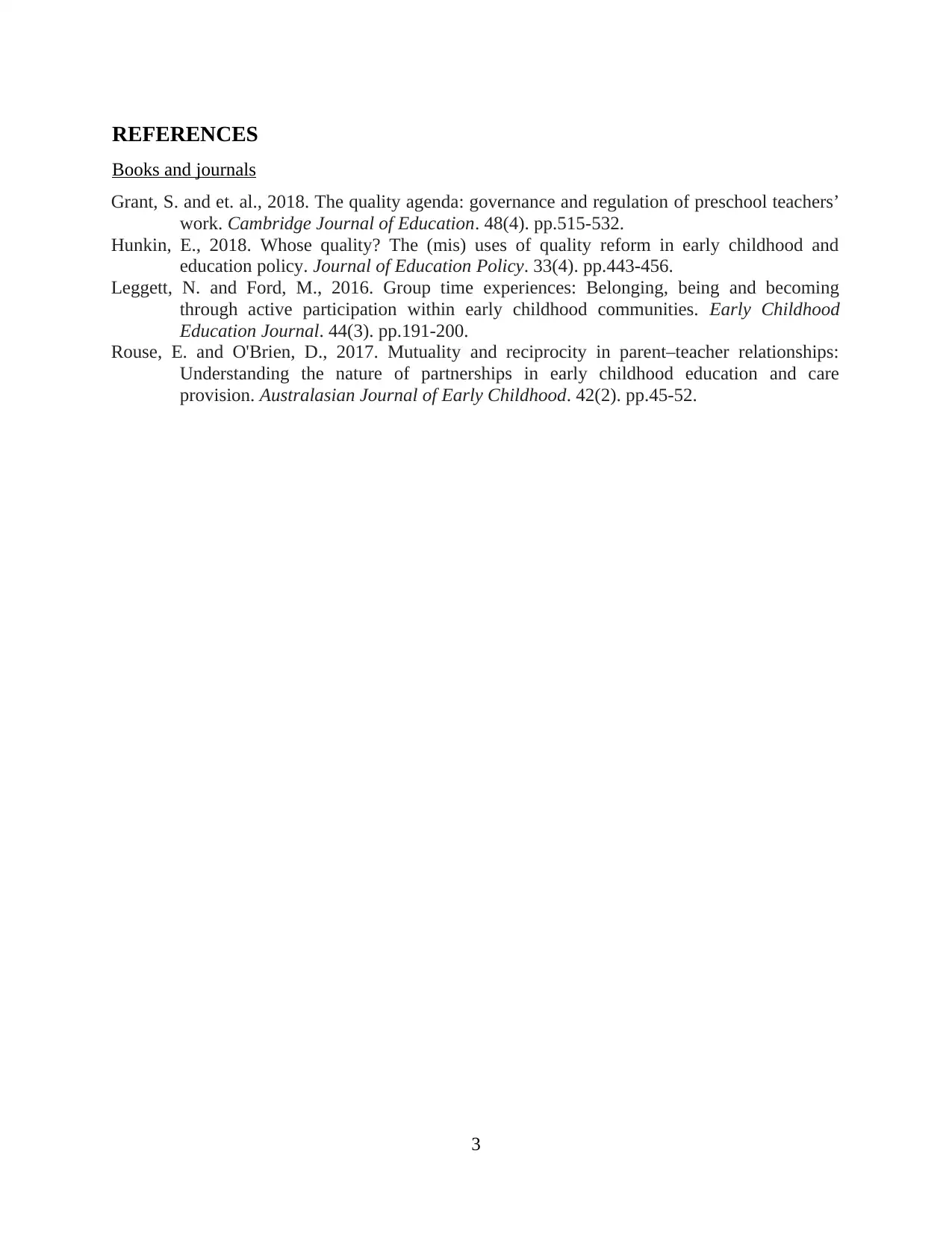
REFERENCES
Books and journals
Grant, S. and et. al., 2018. The quality agenda: governance and regulation of preschool teachers’
work. Cambridge Journal of Education. 48(4). pp.515-532.
Hunkin, E., 2018. Whose quality? The (mis) uses of quality reform in early childhood and
education policy. Journal of Education Policy. 33(4). pp.443-456.
Leggett, N. and Ford, M., 2016. Group time experiences: Belonging, being and becoming
through active participation within early childhood communities. Early Childhood
Education Journal. 44(3). pp.191-200.
Rouse, E. and O'Brien, D., 2017. Mutuality and reciprocity in parent–teacher relationships:
Understanding the nature of partnerships in early childhood education and care
provision. Australasian Journal of Early Childhood. 42(2). pp.45-52.
3
Books and journals
Grant, S. and et. al., 2018. The quality agenda: governance and regulation of preschool teachers’
work. Cambridge Journal of Education. 48(4). pp.515-532.
Hunkin, E., 2018. Whose quality? The (mis) uses of quality reform in early childhood and
education policy. Journal of Education Policy. 33(4). pp.443-456.
Leggett, N. and Ford, M., 2016. Group time experiences: Belonging, being and becoming
through active participation within early childhood communities. Early Childhood
Education Journal. 44(3). pp.191-200.
Rouse, E. and O'Brien, D., 2017. Mutuality and reciprocity in parent–teacher relationships:
Understanding the nature of partnerships in early childhood education and care
provision. Australasian Journal of Early Childhood. 42(2). pp.45-52.
3
⊘ This is a preview!⊘
Do you want full access?
Subscribe today to unlock all pages.

Trusted by 1+ million students worldwide
1 out of 6
Related Documents
Your All-in-One AI-Powered Toolkit for Academic Success.
+13062052269
info@desklib.com
Available 24*7 on WhatsApp / Email
![[object Object]](/_next/static/media/star-bottom.7253800d.svg)
Unlock your academic potential
Copyright © 2020–2025 A2Z Services. All Rights Reserved. Developed and managed by ZUCOL.





